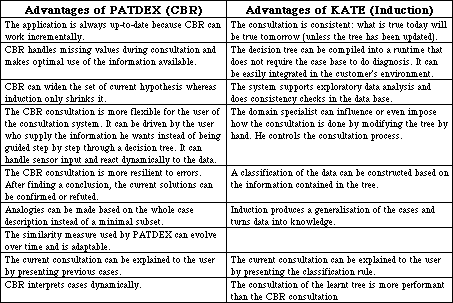|
|
|
We summarize the respective merits of the techniques in the following table. Although the
experiments have been conducted using PATDEX and KATE, the conclusions drawn are
applicable to the underlying technologies in general. Note that according to the distinction
between induction and CBR that has been explained in the introduction, we view tools that
access the training cases to incrementally maintain the induced rules or trees as CBR tools.
|
|
|
|
|
Four critical levels of integration have been identified. For the first level, the two techniques are
seating side-by-side and are provided as stand-alone modules that work on the same case data
expressed in the CASUEL object-oriented language (toolboxstrategy). This is useful
because a single technique may match the user's needs for a particular application, while a
combination of both may not. In addition, a decision tree produced by induction allows to
detect the inconsistencies of a case database before its use by a case-based reasoning module.
For the second level of integration, the two techniques are able to exchange results via the
CASUEL representation language (cooperative strategy). The results of one may help to
improve the efficiency and to extend the classification capabilities of the other. More precisely,
|
|


 1
2
3
4
5
6
7
1
2
3
4
5
6
7

